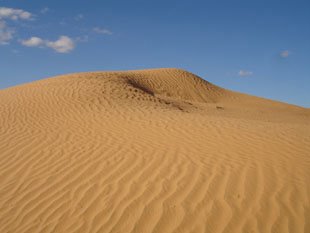 The weather was so cold in Paris that we decided to go in the south Tunisian desert for the last days of 2005 :)
The weather was so cold in Paris that we decided to go in the south Tunisian desert for the last days of 2005 :)This travel gives me the opportunity to observe (and take pictures) many forms of complex natural landform patterns. Sand dunes represent a good example of rich emergent patterns produced by the nonlinear interactions between a very high number of simple agents : sand particules. Sand dunes formation has one basic cause: the transport of sand grains by the wind. They generally start small and disorganized due to the large number of degrees of freedom of sand grains. Once sand begins to pile up, ripples and dunes form. The wind moves individual grains along the inclined windward surface until they reach the crestand then cascade down the steep leeward side. Dunes formation relies upon the weight and size of the sand grains in relation to the wind force. Fine sand particles tend to produce a strong relief, the dunes having a short wave length, while coarse sand produces rounded dunes with a long wave length.
The sand accumulates into ridges which originally lie parallel to the direction of the prevailing winds. Over time these ridges create more irregular arrangement of hills and hollows. Global patterns emerge through interactions and mergers between these forms. Crescent shaped wind blown dunes spawn new dunes from their downwind pointing horns. This could be viewed as some sort of a simple self-reproduction mechanism.

No comments:
Post a Comment